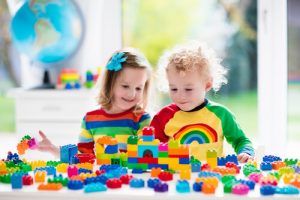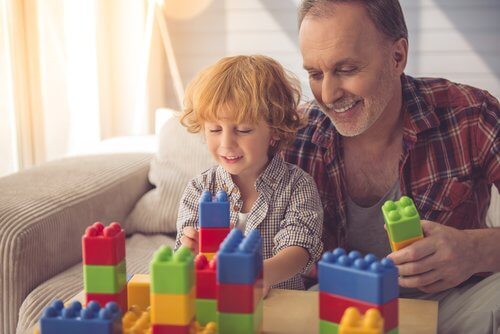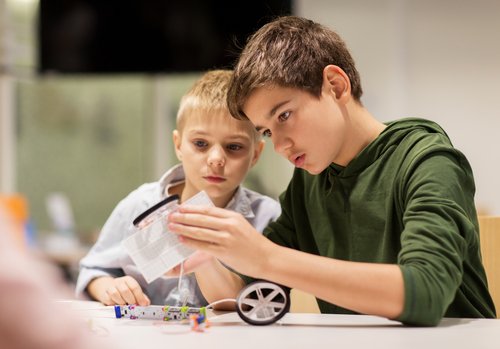The Benefits of Construction Games for Children

If your child enjoys arming and disarming toys, this article will interest you. We’ll review the benefits of playing with building blocks and also mention the different construction games available.
Constructing walls, houses, buildings and bridges is as challenging as it is entertaining for children.
Depending on their age, building blocks can vary in size and difficulty, however they’ll always be beneficial for your child’s development.
Everyone remembers using objects they found around the house to build a fort or castle. Although this seems like a simple pastime, construction is an extremely enriching activity for a child’s intellect.
These types of construction games can begin from the first year a child begins to coordinate their movements.
At first, logically, they can only fit pieces together or knock them down, but they’ll learn little by little.
After a while, they’ll become true professionals when it comes to constructing, either with the classic Lego’s or one of the many similar toys available today.
Benefits of construction games for children
Here are a few of the positive effects that these toys can have on your children:
- Development of their coordination and fine motor skills. By playing with building blocks, children acquire greater skills with their hands. This is especially true for girls who usually develop faster.
- They help them learn geometrical shapes, colors, sizes and spatial concepts.
- They stimulate skills such as concentration, attention, creativity and imagination.
- These toys require planning a scheme or model to follow. If played within a group, the child can also learn about cooperation and teamwork.

- They promote a child’s understanding of reality and they can also teach children about roles and functions when they play with other children.
- Building blocks help children familiarize themselves with the laws of physics such as gravity and balance. They can learn these concepts while playing with levers, inclined planes and in advanced levels, pulleys.
- They help increase a child’s self-esteem and confidence. When they achieve certain objectives and see that their effort is appreciated by their parents, this will make them proud and motivated to excel.
- They promote organization, as long as you teach them to collect all their toys when playtime is over.
“Construction games are extremely enriching activities for a child’s intellect and motor skills”
Where should your child’s construction games take place?
Naturally a child’s favorite play space is their home. It’s important for children to have elements to interact with at their disposal.
In addition to the advantages mentioned above, these toys are a good option for rainy days or when the child is sick.
There are endless possibilities of what can be constructed. You can even find useful videos online to learn new techniques for building.
Building games are also an ideal activity for classrooms. This is especially true during their early years. A teacher’s presence and advice can be a great help to the process.
According to a report by UNICEF and OEI, a teacher’s participation can enrich the game and its learning dynamics by introducing roles, models and materials.

Types of construction games for children
As we previously mentioned, nowadays there are many brands available apart from the classic Lego’s. There are a great variety of models at our disposal.
Here are a few examples:
- Blocks that build characters and scenarios. These sets have all the necessary pieces to build a robot, a princess’s castles or a fantasy world.
- Blocks to build animals. These sets come with the pieces to create farms, stables and the animals that live in them.
- Service blocks. These sets are ideal for simulating professions. Some sets contain pieces to assemble patrol cars, fire trucks and helicopters.
- Blocks to create a race track. These sets combine two great elements: the construction aspect and the race cars. They also contain racetracks, garages and workshops.
Keep in mind that the game’s pieces, size and difficulty should vary according to your child’s age.
These toys can provide hours and hours of guaranteed fun that never go out of style.
If your child enjoys arming and disarming toys, this article will interest you. We’ll review the benefits of playing with building blocks and also mention the different construction games available.
Constructing walls, houses, buildings and bridges is as challenging as it is entertaining for children.
Depending on their age, building blocks can vary in size and difficulty, however they’ll always be beneficial for your child’s development.
Everyone remembers using objects they found around the house to build a fort or castle. Although this seems like a simple pastime, construction is an extremely enriching activity for a child’s intellect.
These types of construction games can begin from the first year a child begins to coordinate their movements.
At first, logically, they can only fit pieces together or knock them down, but they’ll learn little by little.
After a while, they’ll become true professionals when it comes to constructing, either with the classic Lego’s or one of the many similar toys available today.
Benefits of construction games for children
Here are a few of the positive effects that these toys can have on your children:
- Development of their coordination and fine motor skills. By playing with building blocks, children acquire greater skills with their hands. This is especially true for girls who usually develop faster.
- They help them learn geometrical shapes, colors, sizes and spatial concepts.
- They stimulate skills such as concentration, attention, creativity and imagination.
- These toys require planning a scheme or model to follow. If played within a group, the child can also learn about cooperation and teamwork.

- They promote a child’s understanding of reality and they can also teach children about roles and functions when they play with other children.
- Building blocks help children familiarize themselves with the laws of physics such as gravity and balance. They can learn these concepts while playing with levers, inclined planes and in advanced levels, pulleys.
- They help increase a child’s self-esteem and confidence. When they achieve certain objectives and see that their effort is appreciated by their parents, this will make them proud and motivated to excel.
- They promote organization, as long as you teach them to collect all their toys when playtime is over.
“Construction games are extremely enriching activities for a child’s intellect and motor skills”
Where should your child’s construction games take place?
Naturally a child’s favorite play space is their home. It’s important for children to have elements to interact with at their disposal.
In addition to the advantages mentioned above, these toys are a good option for rainy days or when the child is sick.
There are endless possibilities of what can be constructed. You can even find useful videos online to learn new techniques for building.
Building games are also an ideal activity for classrooms. This is especially true during their early years. A teacher’s presence and advice can be a great help to the process.
According to a report by UNICEF and OEI, a teacher’s participation can enrich the game and its learning dynamics by introducing roles, models and materials.

Types of construction games for children
As we previously mentioned, nowadays there are many brands available apart from the classic Lego’s. There are a great variety of models at our disposal.
Here are a few examples:
- Blocks that build characters and scenarios. These sets have all the necessary pieces to build a robot, a princess’s castles or a fantasy world.
- Blocks to build animals. These sets come with the pieces to create farms, stables and the animals that live in them.
- Service blocks. These sets are ideal for simulating professions. Some sets contain pieces to assemble patrol cars, fire trucks and helicopters.
- Blocks to create a race track. These sets combine two great elements: the construction aspect and the race cars. They also contain racetracks, garages and workshops.
Keep in mind that the game’s pieces, size and difficulty should vary according to your child’s age.
These toys can provide hours and hours of guaranteed fun that never go out of style.
All cited sources were thoroughly reviewed by our team to ensure their quality, reliability, currency, and validity. The bibliography of this article was considered reliable and of academic or scientific accuracy.
- Rodríguez, G., & Patricia, C. (2016). Juegos de construcción en el desarrollo lógico matemático de los niños y niñas de 4 y 5 años de la Escuela Pablo Muñoz Vega, del Distrito Metropolitano de Quito, periodo 2015-2016 (Bachelor’s thesis, Quito: UCE). http://200.12.169.19/handle/25000/12043
- Piedra Japón, C. A. (2016). Utilización de los juegos de construcción para potenciar la creatividad de las niñas y niños de 4 a 5 años de edad del nivel inicial II de la escuela José Miguel Burneo Burneo de la ciudad de Loja periodo 2014-2015(Bachelor’s thesis). https://dspace.unl.edu.ec/handle/123456789/11091
- López Mendez, J. S. (2015). Juegos de construcción para reforzar la coordinación viso-motriz de los niños y niñas de nivel inicial 1 de la escuela de educación básica los Ositos Graciosos del Cantón La Libertad, provincia de Santa Elena, año lectivo 2015-2016 (Bachelor’s thesis, La Libertad: Universidad Estatal Península de Santa Elena, 2015.). https://repositorio.upse.edu.ec/xmlui/handle/46000/3674
This text is provided for informational purposes only and does not replace consultation with a professional. If in doubt, consult your specialist.








